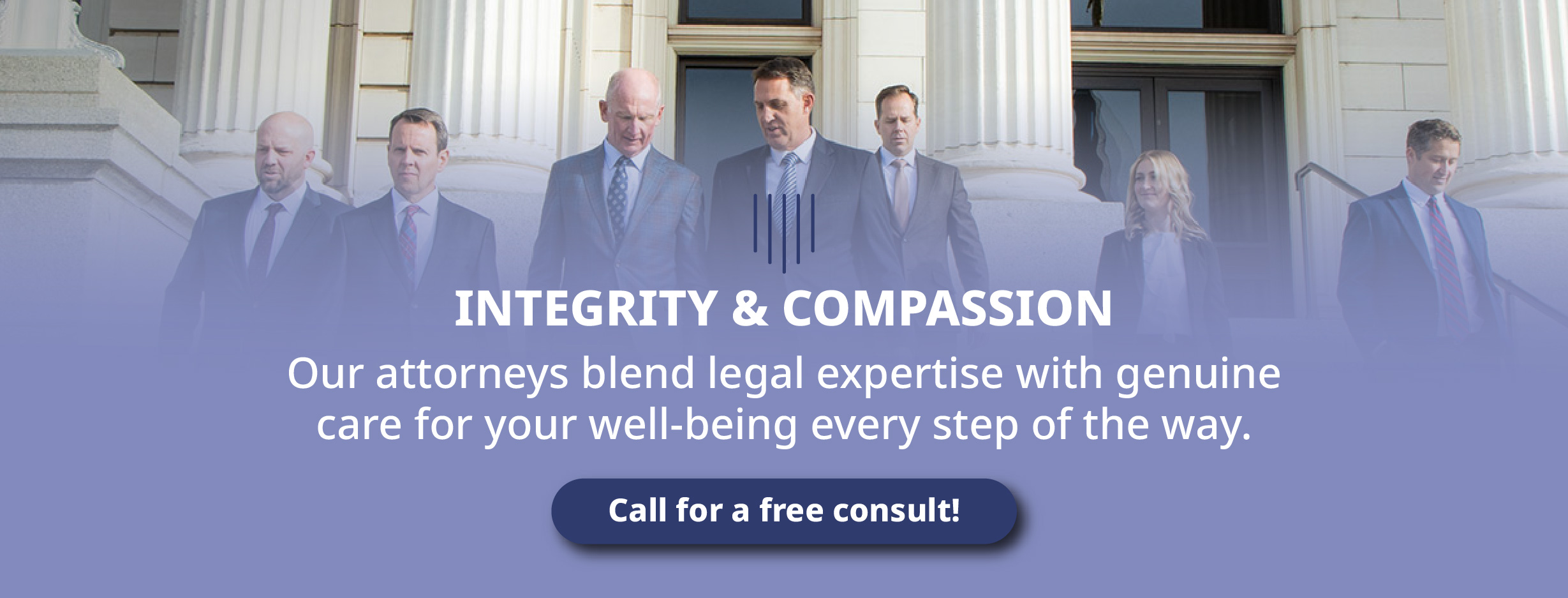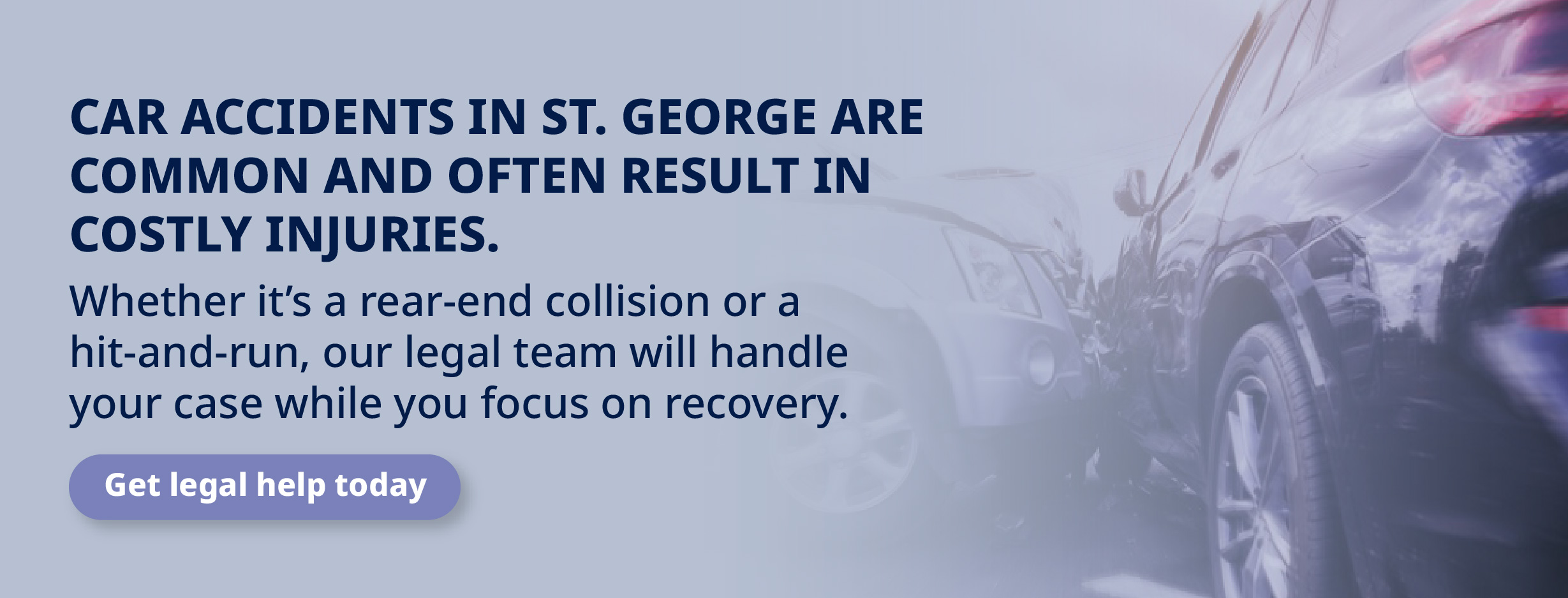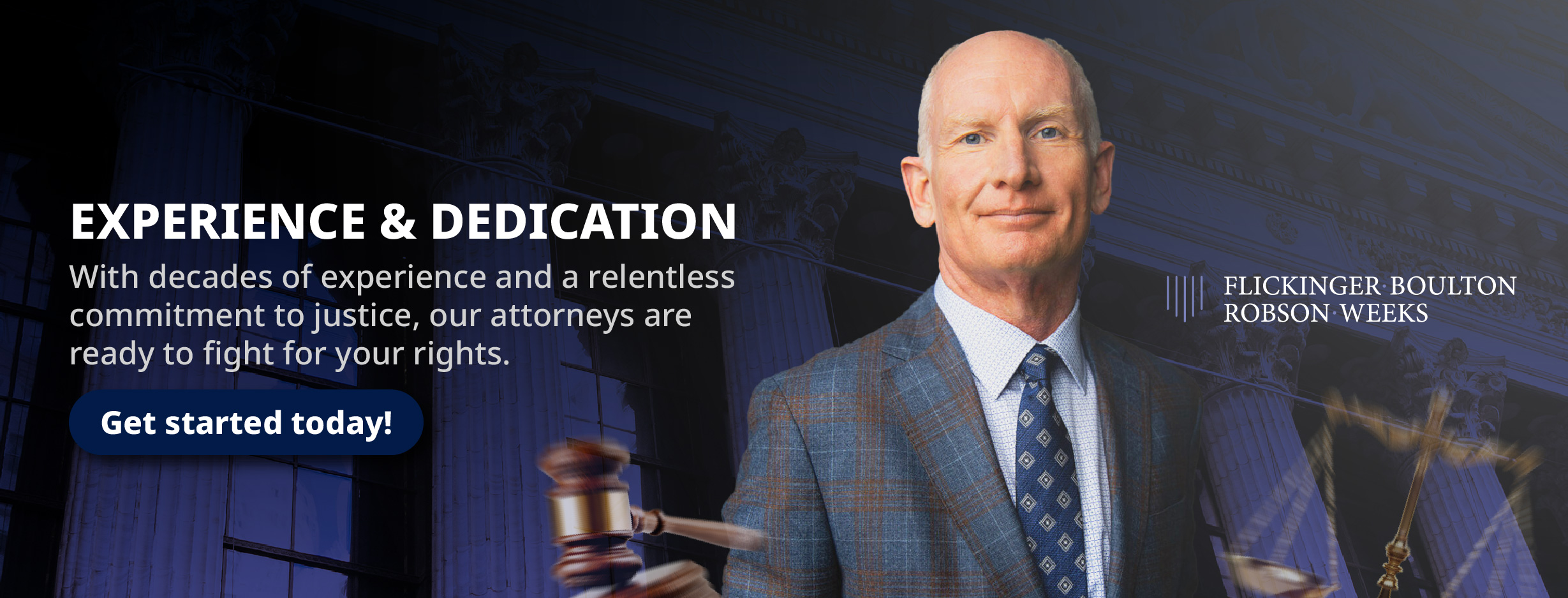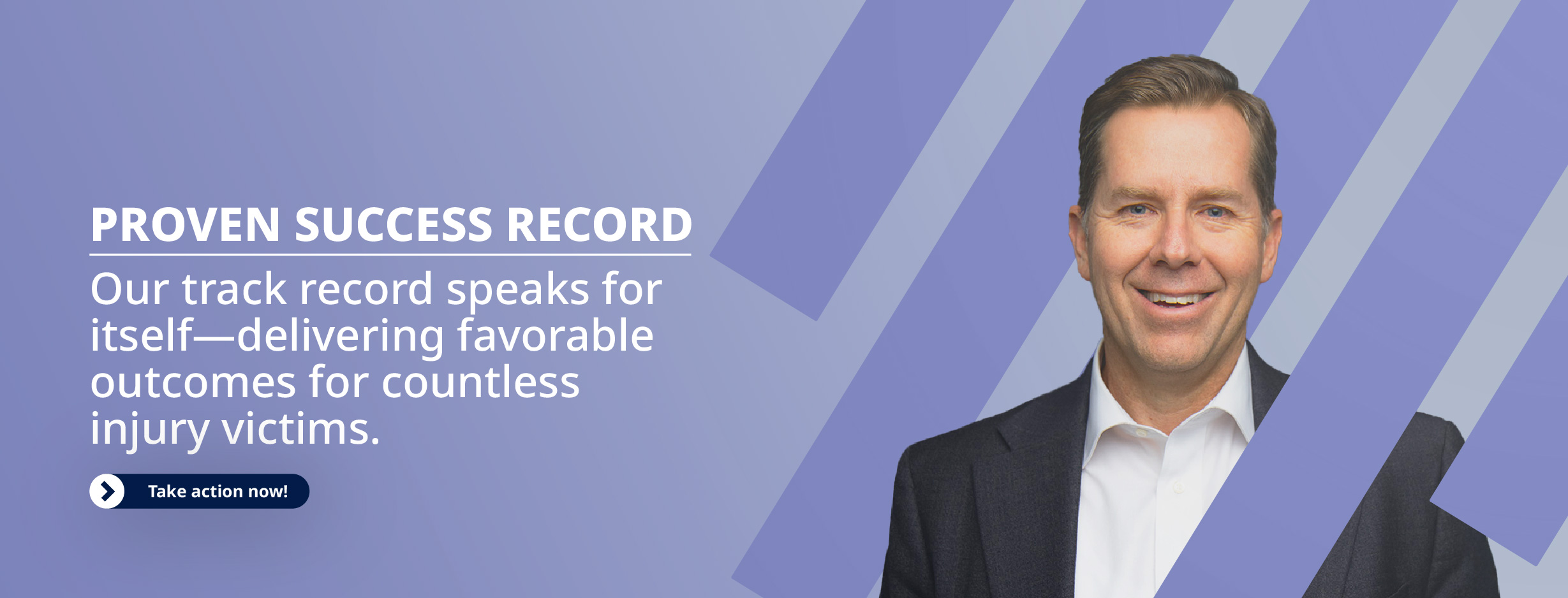Suppose you are cruising along a familiar route in St. George, enjoying the scenery, when a sudden collision turns your day into chaos. Perhaps a driver sped through a red light, sideswiped you unexpectedly, or ran you off the road. In the blink of an eye, you find yourself facing physical pain, mounting medical bills, and the shock of dealing with insurance claims. It is normal to feel uncertain or even overwhelmed in this situation.
It’s completely natural to feel overwhelmed when you’re uncertain about your rights or how Utah law can assist you in getting back lost wages, cover car repairs, or pay for ongoing therapy. The stress can mount even more if the driver at fault and their insurance company are arguing about who’s responsible, making you worry about how your expenses will be handled.
Fortunately, help is close at hand.
Flickinger Boulton Robson Week, having secured multi-million dollar settlements in car accident cases, is here to help. With offices in West Jordan, Provo, and all throughout Utah, including St. George, a thriving community known for its family-friendly vibe and strong sense of growth, our firm is committed to easing your concerns and working toward a fair resolution.
On this page, we’ll discuss the common causes of St. George car accidents, Utah’s legal framework, and how to protect yourself after a crash. By understanding your options, you can pursue rightful compensation while focusing on your healing.
St. George has become a bustling center in southwestern Utah, celebrated for its warm climate, outdoor recreation, and vibrant local businesses. Nevertheless, increased activity also brings busier roads.
In recent years, local roads and interstate routes have seen a growing number of vehicles, from commuting residents to travelers visiting national parks. As traffic surges, so does the risk of accidents.
Statistics reveal that Utah experiences tens of thousands of reported car collisions each year statewide, leading to thousands of injuries. While many St. George residents enjoy relatively safe travels, certain factors such as speeding, distracted driving, or tricky intersections still cause collisions that can upend lives in seconds.
Local law enforcement continuously works to reduce accidents, stationing officers around problem zones and publicizing safety campaigns. Even so, incidents still happen, and a moment’s inattention can produce devastating outcomes.
Car accidents in St. George range from minor fender benders to severe wrecks resulting in significant injuries or death. Multi-lane highways, complicated intersections, and high-traffic areas near shopping centers create extra risk for collisions. Additionally, the area’s tourism-driven movement can lead to more out-of-town drivers unfamiliar with local roads or typical driving patterns.
When you or someone you care about is involved in a crash, the consequences can extend well beyond immediate car damage. Treatment for fractures, concussions, or other traumas can require lengthy hospital stays, therapy, or surgeries. Meanwhile, you might lose wages by taking time off work or need ongoing care that drains your finances. Emotional distress can also linger, affecting daily routines and family relationships.
Understanding this environment underscores why promptly pursuing help is vital if you are harmed in a St. George car accident. The more you learn about how these crashes occur and the steps to protect your well-being, the stronger you stand if you need to file a claim.
Partnering with a law firm such as Flickinger Boulton Robson Weeks can reduce confusion, enabling you to focus on healing rather than fighting over liability or insurance coverage. Our legal team offers both knowledge of Utah traffic laws and compassion for the anxieties you face.
By taking action quickly, you can gather critical evidence and ensure no filing deadlines pass. This way, you safeguard your right to claim fair compensation for medical bills, lost earnings, or ongoing emotional impacts.

Car accidents in St. George often result from behaviors or conditions that are entirely preventable, particularly when drivers neglect basic safety practices. Below are a few prominent causes of car accidents:
Whatever the cause, the result for victims often includes medical emergencies, insurance hassles, and a changed outlook on daily life. One careless act can devastate families physically and financially.
Identifying the root cause, whether it is a phone-based distraction or ignoring the speed limit, helps build a case for compensation. Evidence such as phone records, eyewitness statements, or traffic camera footage can all help pin down who is responsible. Once the liable party is properly identified, you can pursue fair compensation for your losses.

To navigate a car accident claim effectively, you must grasp Utah’s legal framework, which also applies in St. George. Here are key principles that could affect your case:
Utah is a no-fault state for minor auto accidents. This means each driver typically depends on Personal Injury Protection (PIP) coverage for initial medical expenses and lost wages, irrespective of who caused the crash.
Usually, you cannot sue the other driver unless your injuries reach a threshold: for instance, surpassing 3000 dollars in medical bills or involving permanent impairment or disfigurement. If these conditions apply, you can step outside the no-fault system and file a liability claim.
Utah follows a comparative negligence model, meaning fault can be allocated among all parties. If you hold under 50 percent of the blame, you can still receive compensation, though your award decreases by your share of fault.
If a court decides you are 20 percent liable, and your total damages are $10,000, you can get $8,000. But if your responsibility hits 50 percent or more, you might not collect anything. Thorough proof helps push that percentage onto the at-fault driver’s side.
Usually, you have four years from the accident date to file a personal injury lawsuit. Missing that deadline often forfeits your right to legal recourse. Exceptions might arise if a government entity is involved or if the injured is a minor.
Additionally, if a wrongful death occurs due to the crash, different deadlines may apply. Consulting with one of our experienced car accident lawyers soon after an accident ensures you do not miss these time limits.
Utah requires drivers to maintain at least $25,000 bodily injury coverage per person, $65,000 per accident, and $15,000 property damage coverage. While this protects some expenses, serious collisions often exceed these amounts.
This gap is why many seek compensation from the at-fault driver’s higher policies or turn to their own underinsured coverage if the other party lacks enough coverage.
Utah mandates offering Uninsured and Underinsured Motorists Coverage. If a driver who hit you does not have coverage or has insufficient coverage, you can file a claim under your own UM/UIM policy.
That can be vital for major crashes. However, proving your injuries exceed no-fault thresholds might still be necessary to seek these additional benefits.
You must report crashes with injuries or $1,500 or more in property damage to law enforcement. A police report clarifies initial facts and can help in subsequent insurance or legal processes.
By aligning these laws with the specifics of your St. George crash, you can see if you qualify to step beyond PIP coverage or if you might face partial fault challenges. That knowledge empowers you to form a solid approach, aided by legal counsel if needed, to secure full restitution for your losses.
A car crash can disorient you, but your immediate and short-term actions can protect both your health and your potential legal claim:
By following these steps, you reduce the chance of losing important evidence or being pressured into a hasty low settlement. Each action, from taking pictures at the scene to maintaining consistent medical records, supports your effort to get the coverage you need for your recovery.

Assigning blame after a car accident can be straightforward if one driver is clearly at fault, but disputes often arise. In St. George, as across Utah, understanding who caused the wreck is key for claiming damages:
Pinpointing responsibility rests on objective facts. By collecting police statements, witness testimony, and physical data, you show how the crash truly unfolded. Having a lawyer orchestrate these steps ensures no proof is overlooked, and you are not unfairly saddled with blame.
Insurance adjusters often contact you soon after a collision, hoping to wrap up the claim quickly. Navigating these discussions thoughtfully can help secure a fair settlement:
Facing insurance adjusters alone often leads to smaller settlements. By staying organized, cautious, and possibly enlisting professional help, you can improve your odds of receiving adequate compensation for your car repairs, medical needs, and emotional burdens.

When you suffer injuries in a car crash that is not your fault, Utah law entitles you to pursue financial relief. By detailing all losses thoroughly, you strengthen your claim for fair compensation.
This category encompasses everything from the ambulance ride to emergency room visits, follow-up medical checks, prescriptions, and physical therapy sessions. Significant collisions may also require surgeries or rehabilitation stints.
Holding onto every invoice or receipt, including for braces, wheelchairs, or pain medications, is crucial. If your care is likely to continue, you can also project future treatment costs. Professional opinions from physicians help confirm the need and cost for surgeries down the road.
If injuries force you to miss weeks or months of work, you can recover those lost earnings. Your employer’s statements or pay stubs often confirm how much you missed. In cases of lasting disability that prevents returning to your old job, you might additionally seek damages for diminished earning capacity.
This difference between your previous and new earning potential can be substantial, especially if your career demanded physical capability.
If the crash damaged or totaled your vehicle, you can claim repair or replacement costs. You might also recoup expenses for rental cars. Salvaging receipts or repair estimates from trusted mechanics proves the actual property loss. If personal belongings in your car were broken, they can be included too.
Utah allows non-economic damages for emotional distress, chronic pain, or any significant change in your daily enjoyment of life. The severity of the crash and your injuries typically guide how much you seek. Maintaining a personal journal about your pain levels, your frustration with physical limits, or any psychological after-effects supports this category.
In very serious cases, a spouse or immediate family member might argue the accident robbed them of your companionship or household contributions. For instance, if you can no longer help with child care or household tasks, their burden intensifies.
Reserved for particularly gross or malicious conduct, such as if the at-fault driver was excessively intoxicated. They are not awarded in every case, but can increase your financial recovery if the court sees clear evidence of extreme recklessness.
Calculating your damages must be precise. Accepting an early insurance offer before you know the full impact can leave you paying out of pocket.
A lawyer can coordinate medical experts, vocational specialists, and thorough documentation to show the total effect on your health, finances, and emotional well-being. Presenting such a comprehensive picture encourages the insurer or a jury to grant an amount that truly reflects your losses, both now and in the future.

Flickinger Boulton Robson Weeks, we understand that a car accident can disrupt your life in ways you never imagined. From ambulance bills to lost time at work, the effects can be overwhelming.
Our mission is to shoulder the legal load so you can focus on healing and restoring normalcy. We provide personalized consultation and case review, investigate the collision thoroughly, handle insurance communications, calculate long-term damages, negotiate or litigate, and offer ongoing support.
Our comprehensive approach is designed to ease your emotional burdens and guide you through each phase with empathy and clarity. Here are the ways we help.
Flickinger Boulton Robson Weeks brings together thorough investigation, skilled negotiation, and heartfelt dedication to passionately advocate for you, striving to achieve the outcomes you truly need and deserve.

In Utah, you have four years from the accident date to file a personal injury lawsuit. It’s best to act promptly, as this preserves evidence and helps lessen the stress of last-minute filings. Our team of lawyers will stand by you to ensure you avoid missing your chance to seek the justice you deserve.
No. Many claims settle privately without a court hearing. Adjusters typically want to avoid trial costs. If negotiations stall or the insurer denies valid claims, your lawyer may recommend filing suit. Even then, settlements can occur mid-litigation if a compromise emerges.
You can turn to your own uninsured or underinsured motorist coverage if your policy includes it. If that also fails to cover significant expenses, an attorney can explore whether other parties share fault, such as a negligent manufacturer or government entity, if road conditions played a role.
Yes, under Utah’s comparative negligence. If you are less than 50 percent at fault, you can recover damages, though they reduce by your fault percentage. If you bear 50 percent or more, you may receive nothing. Properly documenting how the other driver contributed is essential.
Most personal injury attorneys, including those at Flickinger Boulton Robson Weeks, work on a contingency basis, taking fees only if you secure a settlement or court verdict. This means you pay no retainer or hourly bills. We encourage you to confirm fee arrangements with your lawyer during the initial consultation to ensure you feel financially secure.
Being involved in a serious car accident in St. George can leave you grappling with pain, emotional strain, and overwhelming costs. Flickinger Boulton Robson Weeks is here to guide you through each step, from dealing with insurers to presenting evidence of the other driver’s fault.
Our firm has a proven record of success in Utah, including major settlements that have help families recoup medical bills, lost wages, and more.
Call us at (801) 500-4000 to schedule your free consultation.
Bicycle Accidents
Motorcycle Accidents
Boating Accidents
Recreational Vehicle Accidents
Bus and Mass Transit Accidents
Pedestrian Accidents
Automobile Accidents
ATV or UTV Rollovers
Commercial Vehicle Accidents
Semi Truck and Trailer Accidents
UTAH INJURY LAWYERS
Flickinger • Boulton
• Robson • Weeks
PROVO OFFICE
3000 N University Ave
Suite 300
Provo, UT 84604
SOUTH JORDAN OFFICE
10393 S. Temple Dr.
Suite 103
South Jordan, Utah 84095
OFFICE HOURS
Monday- Friday: 8AM-5PM
Saturday-Sunday: Closed
*Disclaimer: the information provided by this website is for informational purposes only and should not be considered legal advice or a substitute for competent legal counsel.
**SMS consent and contact phone numbers will not be shared or sold to third parties or their affiliates for any purpose.
© 2025 All Rights Reserved.